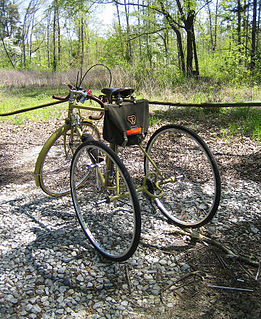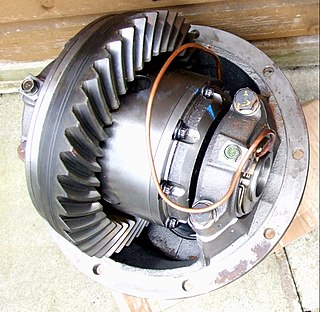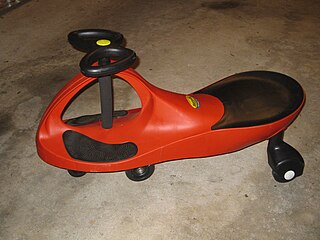
The VW Type 128 and 166 Schwimmwagen were amphibious four-wheel drive off-roaders, used extensively by German ground forces during the Second World War. The Type 166 is the most numerous mass-produced amphibious car in history.

An axle or axletree is a central shaft for a rotating wheel or gear. On wheeled vehicles, the axle may be fixed to the wheels, rotating with them, or fixed to the vehicle, with the wheels rotating around the axle. In the former case, bearings or bushings are provided at the mounting points where the axle is supported. In the latter case, a bearing or bushing sits inside a central hole in the wheel to allow the wheel or gear to rotate around the axle. Sometimes, especially on bicycles, the latter type axle is referred to as a spindle.

A tricycle, often abbreviated to trike, is a human-powered three-wheeled vehicle.

The penny-farthing, also known as a high wheel, high wheeler or ordinary, was the first machine to be called a "bicycle". It was popular in the 1870s and 1880s, with its large front wheel providing high speeds and comfort.

A velomobile, velomobiel, velo, or bicycle car is a human-powered vehicle (HPV) enclosed for aerodynamic advantage and/or protection from weather and collisions. They are similar to recumbent bicycles, pedal go-karts and tricycles, but with a full fairing. A fairing may be added to a non-faired cycle, or the fairing may be an integral part of the structure, monocoque like that of an airplane. The term velomobile can be thought of as similar in scope to the cycle world as the term automobile is to the automotive world.
Automobile handling and vehicle handling are descriptions of the way a wheeled vehicle responds and reacts to the inputs of a driver, as well as how it moves along a track or road. It is commonly judged by how a vehicle performs particularly during cornering, acceleration, and braking as well as on the vehicle's directional stability when moving in steady state condition.

In automotive design, an FF, or front-engine, front-wheel-drive (FWD) layout places both the internal combustion engine and driven roadwheels at the front of the vehicle.

A locking differential is designed to overcome the chief limitation of a standard open differential by essentially "locking" both wheels on an axle together as if on a common shaft. This forces both wheels to turn in unison, regardless of the traction available to either wheel individually.

A velocipede is a human-powered land vehicle with one or more wheels. The most common type of velocipede today is the bicycle.

Vehicles for human transport that have two wheels and require balancing by the rider date back to the early 19th century. The first means of transport making use of two wheels arranged consecutively, and thus the archetype of the bicycle, was the German draisine dating back to 1817. The term bicycle was coined in France in the 1860s, and the descriptive title "penny farthing", used to describe an "ordinary bicycle", is a 19th-century term.

The Eliica is a battery electric vehicle prototype or concept car first shown in 2004 and designed by a team at Keio University in Tokyo, led by Professor Hiroshi Shimizu. The 5.1 m (17 ft) car runs on a lithium-ion battery and can accelerate from 0–100 km/h (62 mph) in four seconds. In 2004, the Eliica reached a speed of 370 km/h (230 mph) on Italy's Nardò High Speed Track. The team's goal is to exceed 400 km/h (250 mph), breaking the record set by today's street-legal gasoline-powered vehicles.

A three-wheeler is a vehicle with three wheels. Some are motorized tricycles, which may be legally classed as motorcycles, while others are tricycles without a motor, some of which are human-powered vehicles and animal-powered vehicles.

A camera dolly is a wheeled cart or similar device used in filmmaking and television production to create smooth horizontal camera movements. The camera is mounted to the dolly and the camera operator and focus puller or camera assistant usually ride on the dolly to push the dolly back and forth. The camera dolly is generally used to produce images which involve moving the camera toward or away from a subject while a take is being recorded, a technique known as a "dolly shot." The dolly grip is the dedicated technician trained to operate the dolly by manually pushing it back and forth.

A beam axle, rigid axle or solid axle is a dependent suspension design, in which a set of wheels is connected laterally by a single beam or shaft. Beam axles were once commonly used at the rear wheels of a vehicle, but historically they have also been used as front axles in four-wheel-drive vehicles. In most automobiles, beam axles have been replaced with front and rear independent suspensions.

In automotive design, an M4, or Mid-engine, Four-wheel-drive layout places the internal combustion engine in the middle of the vehicle, between both axles and drives all four road wheels.

The PlasmaCar is a plastic ride-on toy car designed for children,, made popular by Canadian toy distributor PlaSmart. The PlasmaCar can be propelled by wiggling the front steering wheel which is attached to two pivoting wheels touching the ground. It harnesses the natural forces of inertia, centrifugal force, gravity, and friction in order to drive the car forward and backward. It does not require a power source such as batteries, fuel, pedals, or gears - it simply runs on the child's ability to wiggle the steering wheel. It can be operated indoors and/or outdoors, though it works best on a smooth, flat surface.
PlaSmart is a Canadian-based, global toy distributor located in Ottawa, Ontario that specializes in toys and games that develop motor skills, hand-eye coordination, problem-solving, and creative play. Formed in 2003 by Canadian entrepreneur Timothy Kimber, PlaSmart launched its first product, the PlasmaCar, to the North American market. The company has since grown to 14 employees and over 90 sales contractors, with products available worldwide in more than 60 countries.

A zero-turn riding lawn mower is a standard riding lawn mower with a turning radius that is effectively zero. Different brands and models achieve this in different ways, but hydraulic speed control of each drive wheel is the most common method. Both commercial duty and homeowner models exist, with varying engine power options, size of cutting decks, fuel type, and prices. A z-turn mower typically drives faster and costs more than a similarly sized conventional riding mower that has steerable front wheels.

The E84BMW X1 is a Compact luxury crossover SUV and was produced from 2009 to 2015. It is the first generation model of the BMW X1 range, and was replaced by the F48 BMW X1 in mid-2015.
















